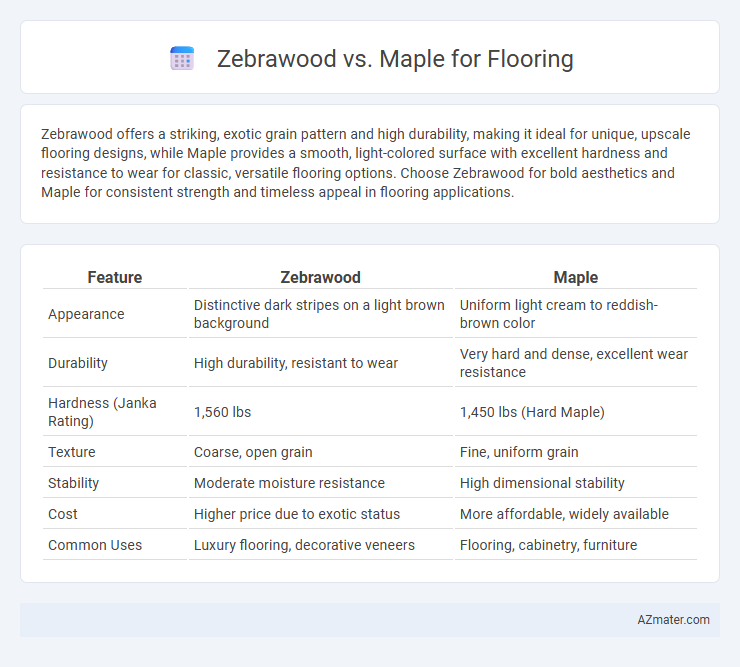Zebrawood offers a striking, exotic grain pattern and high durability, making it ideal for unique, upscale flooring designs, while Maple provides a smooth, light-colored surface with excellent hardness and resistance to wear for classic, versatile flooring options. Choose Zebrawood for bold aesthetics and Maple for consistent strength and timeless appeal in flooring applications.
Table of Comparison
| Feature | Zebrawood | Maple |
|---|---|---|
| Appearance | Distinctive dark stripes on a light brown background | Uniform light cream to reddish-brown color |
| Durability | High durability, resistant to wear | Very hard and dense, excellent wear resistance |
| Hardness (Janka Rating) | 1,560 lbs | 1,450 lbs (Hard Maple) |
| Texture | Coarse, open grain | Fine, uniform grain |
| Stability | Moderate moisture resistance | High dimensional stability |
| Cost | Higher price due to exotic status | More affordable, widely available |
| Common Uses | Luxury flooring, decorative veneers | Flooring, cabinetry, furniture |
Introduction to Zebrawood and Maple Flooring
Zebrawood flooring offers a unique, exotic look characterized by its striking dark stripes and high durability, making it ideal for bold, sophisticated interior designs. Maple flooring provides a lighter, more uniform appearance with excellent hardness and resistance to wear, favored for its versatility and timeless appeal in both traditional and contemporary settings. Both woods deliver strong performance and aesthetic value, but Zebrawood stands out for its distinct grain patterns while Maple excels in consistent color and fine texture.
Visual Appearance: Zebrawood vs Maple
Zebrawood features distinctive dark brown to black stripes over a golden-yellow background, creating a bold, exotic, and highly variegated pattern that stands out in flooring. Maple offers a much more uniform and subtle appearance with light creamy tones and occasional reddish hues, providing a clean, smooth aesthetic ideal for contemporary settings. Choosing between Zebrawood and Maple for flooring depends on the preference for a dramatic, eye-catching grain versus a classic, understated look.
Durability and Hardness Comparison
Zebrawood offers exceptional durability with a Janka hardness rating of approximately 1,320, making it resistant to dents and wear in high-traffic areas. Maple, with a higher Janka hardness of around 1,450, provides superior hardness and scratch resistance, ideal for long-lasting flooring surfaces. Both woods exhibit strong durability, but Maple's slightly greater hardness makes it a preferred choice for floors subjected to heavy use.
Cost and Budget Considerations
Zebrawood flooring typically commands a higher price due to its exotic status and unique grain patterns, making it less budget-friendly compared to maple. Maple offers a more affordable option with consistent availability and durability, suiting cost-conscious projects. When budgeting for flooring, the choice between Zebrawood and Maple hinges on balancing aesthetic appeal against long-term investment and material cost.
Maintenance and Cleaning Requirements
Zebrawood flooring demands more frequent maintenance due to its open grain, which can trap dirt and requires regular sealing to prevent moisture damage, whereas maple's dense, closed grain makes it more resistant to stains and easier to clean with basic sweeping and occasional mopping. Cleaning zebrawood often involves specialized wood cleaners and more careful handling to preserve its unique striped appearance, while maple can endure standard hardwood cleaning products without risk of discoloration or wear. Both woods benefit from prompt spill removal, but maple's lower porosity results in fewer long-term upkeep challenges compared to zebrawood.
Environmental Impact and Sustainability
Zebrawood flooring is prized for its striking grain and durability but is often sourced from tropical regions where deforestation and habitat loss pose significant environmental concerns. Maple, particularly when harvested from sustainably managed North American forests, offers a more eco-friendly choice due to its faster growth rate and the availability of certified sustainable options like FSC-certified maple. Choosing maple flooring supports lower carbon footprints and promotes responsible forestry practices, making it a greener alternative compared to imported exotic woods like zebrawood.
Installation Differences Between Zebrawood and Maple
Zebrawood flooring requires precise acclimation and professional handling due to its dense grain and natural oils, which can affect adhesive bonding and finishing. Maple, characterized by its uniform texture and hardness, allows easier nailing and gluing processes, making it more suitable for DIY installations. The installation of Zebrawood often demands specialized tools and expertise to prevent surface damage, while Maple offers more straightforward installation with standard flooring equipment.
Pros and Cons of Zebrawood Flooring
Zebrawood flooring offers a striking aesthetic with its bold, contrasting dark stripes and exceptional durability, making it resistant to wear and ideal for high-traffic areas. However, its natural hardness can make installation challenging and it requires regular maintenance to preserve its finish and prevent damage. Compared to maple, zebrawood is more costly and less common, but it provides a unique, exotic look that enhances the visual appeal of any interior space.
Pros and Cons of Maple Flooring
Maple flooring offers exceptional durability and resistance to wear, making it ideal for high-traffic areas, while its light, creamy color enhances the brightness of any room. However, maple's fine, consistent grain may lack the unique character that zebrawood's dramatic stripes provide, resulting in a more uniform appearance. Additionally, maple's hardness can make installation more challenging and may require specialized tools compared to softer woods.
Which is Better: Zebrawood or Maple for Flooring?
Zebrawood flooring offers striking aesthetics with its bold, striped grain pattern and high durability, making it ideal for statement spaces, while maple flooring provides a more subtle, uniform appearance and excellent hardness suitable for high-traffic areas. Maple's consistent texture and resistance to wear make it a practical choice for families and commercial spaces, whereas zebrawood requires more maintenance due to its porosity and potential for color fading. Choosing between zebrawood and maple depends on desired visual impact, durability needs, and maintenance willingness for long-lasting flooring.

Infographic: Zebrawood vs Maple for Flooring
 azmater.com
azmater.com